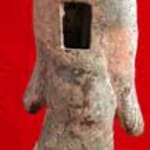Song Bronze Sculpture of a Taoist Immortal, 960 CE - 1279 CE
Bronze
3.25 x 9.5
H.041
After the fall of the T’ang Dynasty, a period of unrest and war ensued, finally ending with the establishment of the Song Dynasty. The Song era was considered a time...
After the fall of the T’ang Dynasty, a period of unrest and war ensued, finally ending with the establishment of the Song Dynasty. The Song era was considered a time of consolidation for Chinese culture. Traditional text were reanalyzed and reinterpreted, bringing forth a revival of Confucianism peppered with new ideas. Once again, civil scholars became more influential than their military counterparts. This was an era of peace, where technology and innovation flourished. Trade now focused on the seas, since the Silk Road had since been cut off. The Song viewed themselves as the culmination of two thousand years of Chinese culture. However, splinters began to emerge among the various ethnic groups that had been unified under the T’ang. As these ethnic rivalries began to grow, the government became fractured as officials began to oppose each other, allowing the Mongols from the north to invade and conquer.
The Taoist immortal has long been a favorite subject o Chinese statuary art. Thes legendary beings are said to have lived at various times and attaine immortality through their studies of Nature’s secrets. Their special powers include the ability to become invisible, raising th dead, changing tangible objects into gold, and transforming their appearance. Shown standing on a rectangular base, this figure wears long crossover robe belted above the waist, high boots, and a squarish cap. The draping folds of the robe are exposed as the figure raises his arms,
assuming a lively gesture that captures the movement of a walking figure. The position of the arms and evidence of holes in the hands implies th figure could have held a walking stick or emblematic object. The figure’s jovial expression is conveyed through th well-modeled eyes, cheekbones, nose and beard that appears to sway with th sound of laughter.
The Taoist immortal has long been a favorite subject o Chinese statuary art. Thes legendary beings are said to have lived at various times and attaine immortality through their studies of Nature’s secrets. Their special powers include the ability to become invisible, raising th dead, changing tangible objects into gold, and transforming their appearance. Shown standing on a rectangular base, this figure wears long crossover robe belted above the waist, high boots, and a squarish cap. The draping folds of the robe are exposed as the figure raises his arms,
assuming a lively gesture that captures the movement of a walking figure. The position of the arms and evidence of holes in the hands implies th figure could have held a walking stick or emblematic object. The figure’s jovial expression is conveyed through th well-modeled eyes, cheekbones, nose and beard that appears to sway with th sound of laughter.



